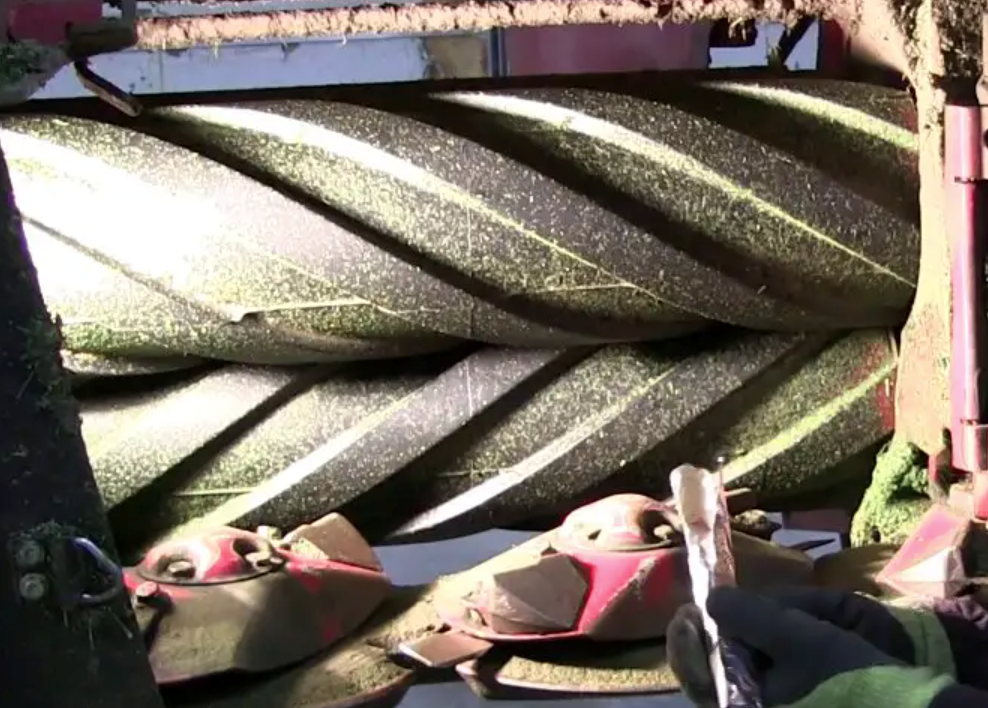Harvest of cool-season perennial grasses, perennial legumes, and winter-annual small grains will begin within three weeks in Indiana. Getting a standing forage crop that measures 75 percent moisture or more to a safe baling moisture of 18 to 20 percent moisture is “easier said than done”. Changing weather fronts pass through every third or fourth day making it a challenge to quickly dry hay. Research has shown that properly conditioning forage crops is the single most effective way to reduce curing time. Making the proper settings on your mower-conditioner will ensure the best economic return.

Properly conditioning forages by checking the gap of the conditioning rolls is the single most effective way to reduce curing time. (Photo Credit: Phil Reid, Purdue Animal Sciences)
When conditioning a forage crop, the goal should be to have 90 percent of the crop’s stems show some signs of a cracking or limpness. No more than 5 percent of the leaves should show signs of bruising or blackening from the conditioning process — this is especially important with legumes.
Remember, over conditioning forage crops will cause excessive leaf loss during the drying process and reduce the crop’s overall yield and quality. At the same time, under conditioning the crop will make it more susceptible to rainfall as it will take longer to dry the crop and requires more mechanical manipulation to dry the hay.
When making the settings to your mower-conditioner, make sure to:
- Alter the conditioning roll gap properly by using the shims located on the roll stops. Refer to your owner’s manual.
- Adjust the conditioning roll pressure to ensure proper conditioning.
- Check conditioning with every cutting or crop change. Variables such as yield, relative forage species composition, and stem diameter change from one crop to the next, or one field to the next.
- Keep the sickle bar and disk mower blades in good cutting.
- Adjust the reel position and speed for adverse conditions, such as a lodged or tangled crop.
- Alter the swath width for drying conditions. Set it wide if the soil is dry and good drying conditions are expected. Create a narrow windrow if the soil is wet. This allows the soil to dry between the windrows. Then, ted the narrow windrows onto the dry parts of the field.
Measuring Conditioning Roll Clearance
Generally, the mower-condition’s roll clearance should range from 1/16 inch to 3/32 inch. If the clearance is less than this range, excessive leaf loss and roll wear can occur. If the clearance is significantly more than this range, then the crop will not be conditioned as effectively, and slower drying rates can be expected. Most mower-conditioner owner’s manuals will indicate the proper clearance level and the correct procedure for making adjustments.
The following procedure can be used to determine the average roll clearance on most roll-type mower-conditioners. To conduct this procedure safely you must:
- Shut off the tractor engine.
- Disconnect the mower-conditioner power take-off (PTO) from the tractor on mechanically driven units.
- Disconnect the mower-conditioner PTO hydraulic pump from the tractor on hydraulically driven units.
- Lower the cutting platform.
The procedure’s steps are:
- Cut three pieces of typical household aluminum foil. Each piece should be 18 inches long and at least 12 inches wide.
- Form three separate rolls from the foil strips by wrapping each one around a length of rod, pipe, or dowel that is 3/8 inch in diameter. Slide the foil roll off the rod, taking care not to crush the foil roll.
- Place one foil roll in the approximate center of the conditioning rolls. Place the other foil rolls about 1 foot from each end of the conditioning rolls. Place the foil rolls so that they are perpendicular to the roll’s longitudinal axis.
- Make sure the cutting platform is fully lowered. This is the only safe way to make this measurement. Furthermore, raising the platform on some mower-conditioners will open and separate the rolls, preventing an accurate measure of the minimum roll clearance.
- Turn the conditioning rolls by hand until the foil rolls come through completely.
- The conditioning rolls will crush the foil. Use a digital or dial caliper to measure the thickness of the crushed foil roll to determine the minimum roll clearance. Take several thickness measurements along the length of each foil roll and determine an overall average. Take the measurement where the “crimp,” or smallest clearance, occurs. The crimped foil thickness should range from 1/16 inch to 3/32 inch.
Doing this “measuring the gap” procedure should result in improved drying rates.
From: Purdue Forage Field Guide, Third Edition. ID-317.


